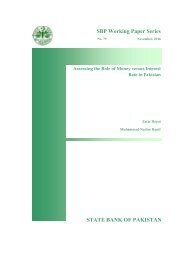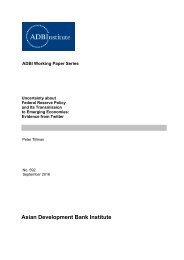SBP Working Paper Series STATE BANK OF PAKISTAN
n?u=RePEc:sbp:wpaper:74&r=mon
n?u=RePEc:sbp:wpaper:74&r=mon
You also want an ePaper? Increase the reach of your titles
YUMPU automatically turns print PDFs into web optimized ePapers that Google loves.
2.1 Monetary Aggregates and Economic Activity<br />
The most straight forward observation regarding the relationship between monetary aggregates 7 and GDP<br />
is that both nominal and real monetary aggregates are strongly procyclical at levels. The first two rows of<br />
scatter plots in Figure 1 and Figure 2 depict a clear positive relationship between monetary aggregates and<br />
GDP. The growth rate of monetary aggregates do not reflect a significant co-movement with GDP (3rd<br />
rows of scatter plots in Figure 1 & 2).<br />
Similarly the real and nominal monetary aggregates at levels depict positive co-movement with LSM<br />
(Figure 3 & 4, row 1 & 2) whereas there is no clear link between monetary aggregate growth rates and<br />
LSM. The only exception is the annual M2 growth rate that shows slight positive co-movement with LSM<br />
(row 3 in Figure 3). These observations give confidence in quarterly GDP to use as a proxy of economic<br />
activity.<br />
The contemporaneous correlations presented in Table A1 confirm these findings by showing that<br />
correlations of monetary aggregates with GDP and LSM are positive and statistically significant.<br />
In order to better understand this strong pro-cyclical behavior of monetary aggregates, we try to<br />
investigate the direction of causation. The dynamic correlations between GDP and different lags of<br />
monetary aggregates (left panel of Figure 7A) are positive. This means that current GDP is positively<br />
associated with lagged monetary aggregates; indicating a leading indicator role being played by money.<br />
On the other hand, different leads of monetary aggregates also show positive correlations with GDP<br />
pointing out that higher income also causes higher money demand.<br />
The dynamic correlations between monetary aggregates and LSM also show similar phenomenon as<br />
shown by the left panel of Figure 7B. The positive correlations at both leads and lags indicates two-way<br />
causality between money and economic activity.<br />
The Granger causality test results presented in Table A2 and A3 seem to further endorse this two-way<br />
causality proposition. The nominal and real M1 and M2 Granger cause GDP and are Granger caused by<br />
GDP in the quarterly data (see Table A3). In annual data, real M1 and M2 show two-way Granger<br />
causality with GDP. The nominal monetary aggregates show a mixed pattern of causality in annual data;<br />
M1 causes GDP and M0 is caused by GDP. However, the growth of monetary aggregates seems to settle<br />
the issue of direction of causality. In quarterly data, growth of M1 and M2 Granger causes GDP whereas<br />
the converse is true in the annual data. This observation signals that in short run, monetary aggregates<br />
fluctuations cause fluctuations in GDP whereas in medium run (annual data) they are caused by GDP<br />
fluctuations.<br />
In order to establish robustness of above mentioned relationships over time, we compare dynamic<br />
correlations calculated using full sample period (1990Q1-2012Q4) with the ones calculated using sample<br />
period 2000Q1-2012Q4. For the two sample periods, dynamic correlations of GDP and LSM fluctuations<br />
with leads and lags of monetary aggregates seem to preserve their overall shape (left panels in Figures 7A<br />
and 7B) and reflect a slight increase in magnitude in the recent time. This indicates that sensitivity of<br />
7 In our empirical analysis, averaging method was used for adjustment of outliers in the series of M0 in 2001q2 and 2009q2, M1 in 1998q1, q3 &<br />
q4, 2004q1 & q3 and M2 in 2004q1 & q3. The series of M1 was adjusted for change of definition of demand deposits using splicing method from<br />
2007 onwards.<br />
7






